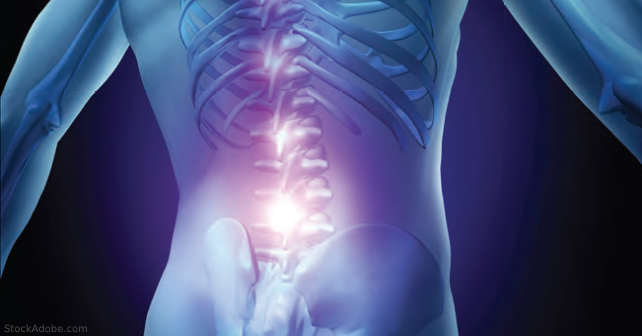
There is no shortage of evidence regarding the harms of opiate use and misuse. With this in mind, prescriptions for opiates have been dropping in the United States, but were still dispensed at a rate of 43.4 prescriptions annually per 100 persons in 2020.1 The emergency department remains an important frontier for work in judicious prescribing, but opiate analgesia remains a valuable tool for the initial treatment of a variety of presentations.
Explore This Issue
ACEP Now: Vol 42 – No 10 – October 2023Which brings us to acute back pain, a frustrating and challenging condition to manage for patients and physicians alike.
Recently, substantial media coverage summarized the OPAL trial published in The Lancet, concerning the use of opiates for acute “spinal” pain—inclusive of both back and neck pain.2 The lay media spin on the article fell onto side of universally negative against the use of opiates. While this reporting is superficially true, it tells only part of the story, and little regarding its relevance to emergency-department practice.
Patients included in this Australian trial were recruited in both the emergency department and in general practice, and were eligible if the current episode of pain began within the past 12 weeks. The authors define this as “acute” pain, and while we certainly see a share of patients in the emergency department suffering from months of pain, we consider these patients as a distinct presentation from those whose pain has rapidly escalated in the preceding 24 to 48 hours. In fact, the original trial protocol required patients to have had pain for at least two weeks prior to recruitment, further limiting generalizability to the scope of patients presenting to the emergency department.
After enrollment, patients were randomized either to a modified-release oxycodone-naloxone combination opiate, starting with an initial dose containing 5 mg of oxycodone, or placebo. Patients were prescribed a schedule of twice-daily analgesia, and were allowed to increase the dose from 5 mg to 10 mg if pain was not initially well-controlled. This may contrast from typical practice using immediate-release preparations to manage severe pain, or from use of oxycodone-acetaminophen or hydrocodone-acetaminophen combination products. The addition of naloxone to the tablets may also provide a confounder in terms of the analgesia provided.
The trial analgesia protocol also differs from typical prescribing in which acute pain is managed by starting from a maximal dose, determined by the clinically necessary analgesic effect, then rapidly decreased as pain improves. Rather, the research protocol describes a prolonged six-week program of follow-up and repeated prescribing. From an emergency department perspective, the scope of initial treatment is rarely, if ever, intended to involve a six-week period of treatment. The treatment response for any six-week program is of limited relevance to the acute treatment provided in the emergency department.
Regardless, the reason this study became widely discussed is because the primary outcome of the trial was negative, concluding there was “no evidence that opioids should be prescribed for people with acute non-specific low back or neck pain.” It is worth parsing this statement semantically, noting the authors do not conclude opioids should not be prescribed, only that evidence is lacking in support. In this respect, the conclusion is absolutely true.
Only one other study of reasonable quality informs practice with respect to opiate analgesia for low back pain in the emergency department. Published in JAMA in 2015, the authors conducted a three-arm trial comparing cyclobenzaprine, oxycodone-acetaminophen, and placebo.3 In contrast to the OPAL study, this trial specifically excluded patients whose pain had persisted for more than two weeks. Patients were all prescribed naproxen in addition to the study medication, and were able to take one or two tablets of these immediate-release preparations up to every eight hours, as needed.
The primary outcome was a more relevant seven-day outcome, rather than six-week follow-up. Like OPAL, this was a “negative” trial, in which there was no “statistically significant” difference between functional outcomes between any groups. It is worth noting, however, that the group with the least pain, the greatest improvement, and the fewest days off work was the group taking oxycodone-acetaminophen. A frequentist approach to this trial would conclude, if the trial were to be repeated many times, nearly all the trials would replicate the favorable effects seen for oxycodone-acetaminophen. A Bayesian approach to interpretation would depend on your prior assumptions regarding the efficacy of opiates for treating acutely painful conditions, and may also support the differences favoring oxycodone-acetaminophen, as well.
Finally, even though a seven-day outcome is more relevant, successful acute treatment in emergency medicine may be better measured by time frames of 72 hours or less. In that respect, these trials, particularly OPAL, provide very little insight into whether opiate analgesia supports this early recovery. Only exploratory outcomes provide some supporting evidence that opiate analgesia may improve return to activities and work, but these observations are weak enough they are best represented as equipoise for future research.
After much ado, we may finally arrive back where we started, with little relevant evidence on this specific topic capable of informing our practice in the emergency department. The analgesic options available to us in the emergency department remain limited, as are the options readily prescribed in oral form for discharge. Attempts to discern an advantage associated with skeletal muscle relaxants were unable to find benefit relating to metaxalone, tizanadine, or baclofen.4 In a similar fashion, even the addition of acetaminophen, or the addition of diazepam, to a non-steroidal anti-inflammatory did not show an advantage in function or analgesia.5,6
Frankly, the only reliable option for improving low back pain appears simply to be time, an unsatisfying situation for both patient and practitioner. Opiate analgesia lacks evidence of both efficacy and inefficacy. However, what has been clearly and repeatedly proven are adverse effects and downstream harms from opiate prescribing. Better evidence directly informing the immediate post-encounter period is sorely needed to either confirm or refute what likely remains widespread and common use in the acute setting.

Dr. Radecki is an emergency physician and informatician with Christchurch Hospital in Christchurch, New Zealand. He is the Annals of Emergency Medicine podcast co-host and Journal Club editor and can be found on Twitter @emlitofnote.
References
- Centers for Disease Control and Prevention. US opioid dispensing rate map. CDC website. https://www.cdc.gov/drugoverdose/rxrate-maps/index.html. Last updated November 10, 2021. Accessed September 17, 2023.
- Jones CMP, Day RO, Koes BW, et al. Opioid analgesia for acute low back pain and neck pain (The OPAL trial): a randomised placebo-controlled trial. The Lancet. 2023;402(10398):304-312.
- Friedman BW, Dym AA, Davitt M, et al. Naproxen with cyclobenzaprine, oxycodone/acetaminophen, or placebo for treating acute low back pain: a randomized clinical trial. JAMA. 2015;314(15):1572.
- Friedman BW, Irizarry E, Solorzano C, et al. A randomized, placebo-controlled trial of ibuprofen plus metaxalone, tizanidine, or baclofen for acute low back pain. Ann Emerg Med. 2019;74(4):512-520.
- Friedman BW, Irizarry E, Chertoff A, et al. Ibuprofen plus acetaminophen versus ibuprofen alone for acute low back pain: an emergency department-based randomized study. Acad Emerg Med. 2020;27(3):229-235.
- Friedman BW, Irizarry E, Solorzano C, et al. Diazepam is no better than placebo when added to naproxen for acute low back pain. Ann Emerg Med. 2017;70(2):169-176.e1
Pages: 1 2 3 | Multi-Page




No Responses to “Are Opiates Futile in Low Back Pain?”